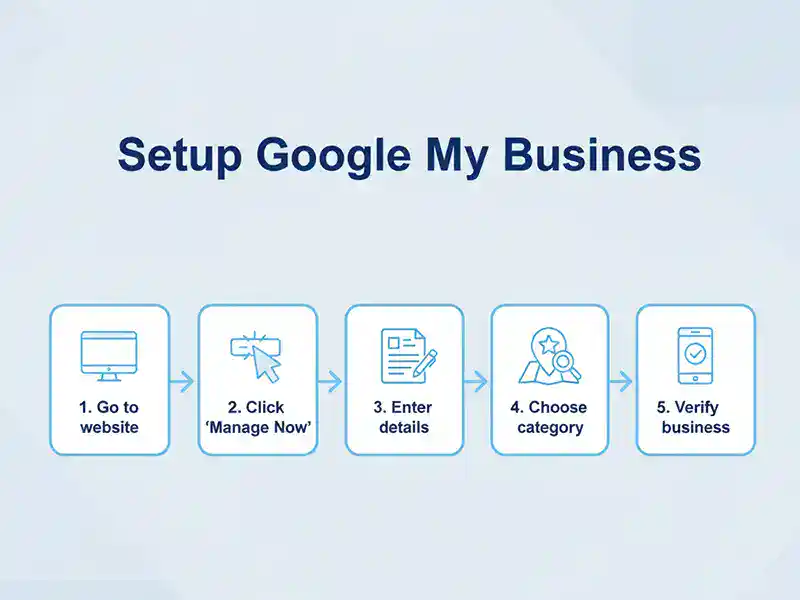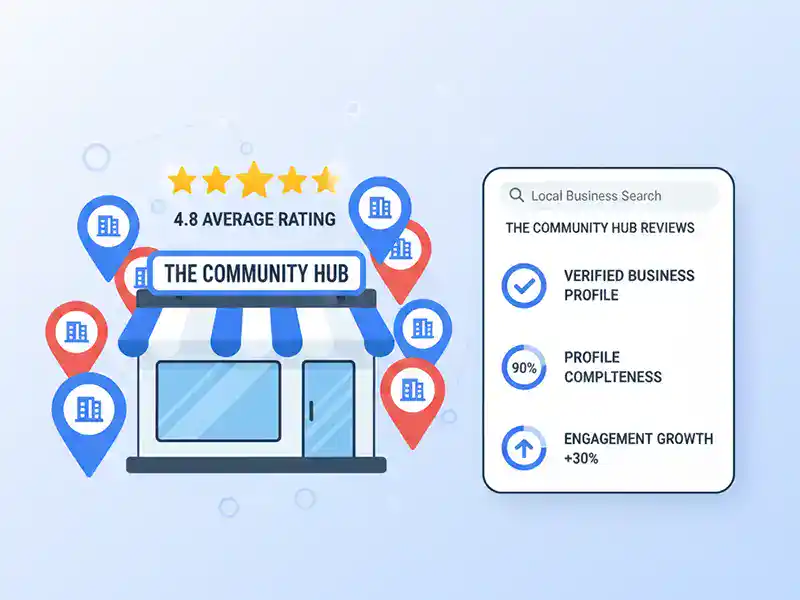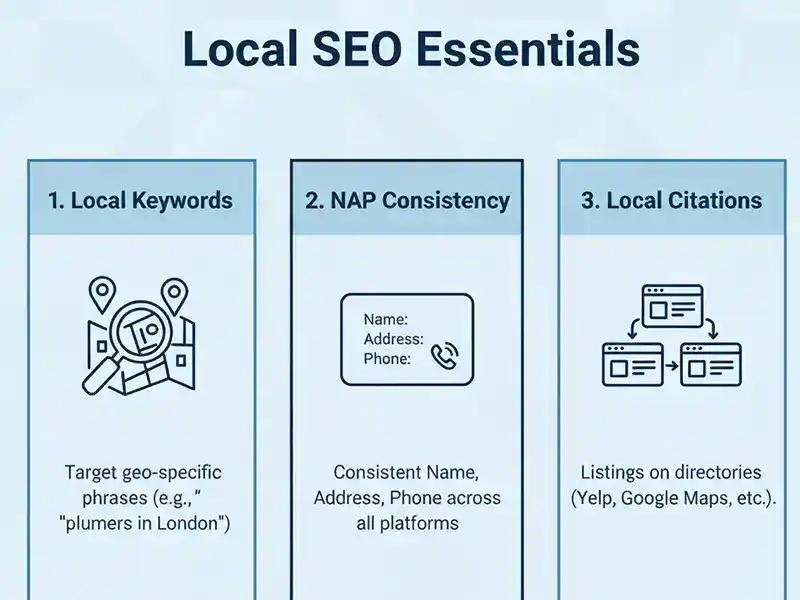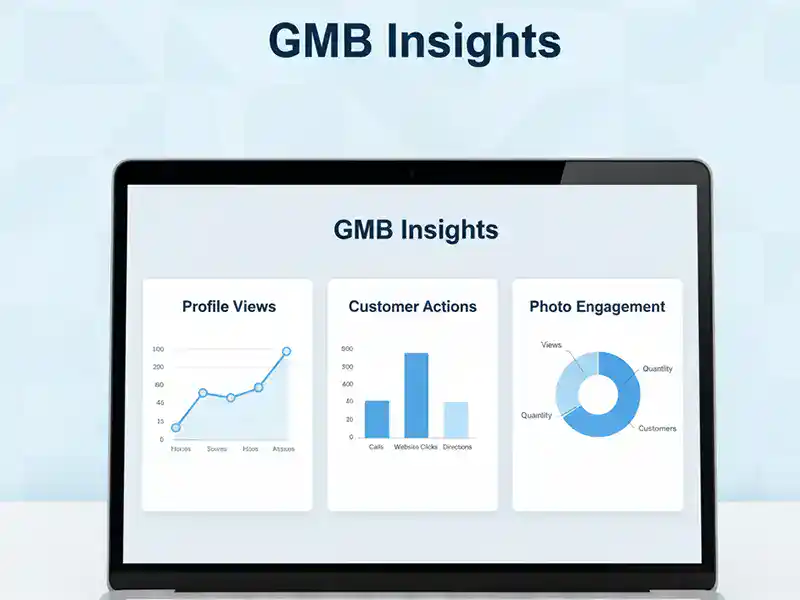Book Appointment Now

A Comprehensive Google My Business Optimization Guide
Introduction to Comprehensive Google My Business Optimization Guide
Understanding Google My Business Optimization
Hey there! If you’re a business owner or someone looking to establish their brand online, you’ve probably heard the term “Google My Business” (GMB) tossed around quite a bit. GMB is a free tool by Google that helps businesses manage their online presence across Google, including search results and Google Maps.
Optimizing your GMB listing is all about making sure your business shows up prominently when people search for services you offer. Think of it as your business card on the internet, but much more powerful because it can reach potential customers right when they are searching for what you provide.
Here are the key components of GMB optimization to consider:
- Complete Your Profile: Filling out all the information accurately is crucial. This includes business name, address, phone number, and services offered.
- Choose the Right Categories: Selecting accurate categories helps Google understand your business and match it with relevant search queries.
- Stay Active: Regular updates, posts, and interaction with customers can keep your profile fresh and engaging.
For example, I once worked with a local bakery that wasn’t appearing in search results. After optimizing their GMB profile, complete with mouth-watering photos and engaging posts about special holiday treats, their foot traffic increased significantly!
Benefits of Optimizing Your Online Visibility
Now, you might wonder, why is all of this effort worth it? Well, optimizing your online visibility through Google My Business brings a ton of advantages! Here’s a quick list of benefits:
- Increased Visibility: When optimized, your business is more likely to appear in local searches, making it easier for potential customers to find you.
- Trust and Credibility: A well-maintained GMB profile signals professionalism. Customers are more likely to trust businesses that provide complete and accurate information.
- Customer Engagement: Engaging with your clientele through posts, images, and reviews can enhance relationships. It shows that you care about your customers’ opinions.
- Local SEO Boost: GMB aligns with local SEO practices, which can help your business rank higher on search engines, driving more traffic your way.
Let me share another quick story: A friend of mine owns a small clothing shop. After optimizing her GMB, she noticed a 30% increase in customer inquiries! The best part? Many customers mentioned that they discovered her shop through the Google Maps listing while searching for nearby clothing stores.
To wrap it up, optimizing your Google My Business profile is like unlocking a treasure chest filled with opportunities. It not only promotes your business but helps you connect with your customers in a meaningful way. So, let’s dive deeper into how to set up your GMB account effectively in the next section!

Setting Up Google My Business
Creating a Google My Business Account
Alright, now that we’ve understood the importance of Google My Business (GMB), let’s get right into setting it up! The first step is to create your GMB account. Don’t worry; it’s pretty straightforward!
- Go to the Google My Business website: Start by visiting the GMB homepage.
- Click “Manage Now”: You’ll see this button pop up on the site. Click it to begin!
- Enter Your Business Name: If it’s already on Google, you’ll see suggestions. If not, you can create a new listing by entering your business name.
- Select Your Business Category: Choose a category that best fits your service. This helps Google understand what you do.
- Provide Your Location: You can either list a physical address or specify service areas.
For example, when I set up my GMB account for my digital marketing business, I made sure to choose “Digital Marketing Agency,” which helped me reach the right audience effectively.
Completing Business Information Accurately
Now that your account is created, it’s time to fill in your business information accurately. This part is crucial because complete and correct data improves your visibility. Here’s what you should focus on:
- Business Name: Make sure it matches the name on your storefront.
- Address: Ensure it’s correct so customers can find you easily.
- Phone Number: Use a local number for trustworthiness.
- Website URL: Link to your official site for more information.
- Business Hours: Keep these updated, especially during holidays.
Completing this section correctly gives potential customers all the details they need to choose your business. I remember helping a local coffee shop set up their information correctly. After they updated their hours and contact details, they saw a significant increase in inquiries, especially on weekends!
Verifying Your Business
Once you’ve filled in your business information, it’s time to verify your business. This step is essential; it adds credibility to your GMB profile. Google typically offers a few methods to verify:
- Postcard Verification: Google will send a postcard with a verification code to your business address. It may take a few days to arrive.
- Phone Verification: If eligible, you can receive a verification call with a code.
- Email Verification: This is another option if Google offers it for your business type.
For my friend’s bakery mentioned earlier, we chose postcard verification. Although waiting a week felt like an eternity, it was worth it! Once verified, they were immediately listed on Google Maps and search results, opening their doors to new customers.
In short, setting up your Google My Business account is a thrilling step toward improving your online presence. Completing your information accurately and verifying your business ensures that your customers can find you easily. Ready to enhance your GMB profile further? Let’s move on to optimization!

Optimizing Your Google My Business Profile
Selecting the Right Categories
Now that we’ve set up and verified our Google My Business (GMB) account, it’s time to make it shine! One of the key factors in optimization is selecting the right categories for your business. This step is important because it helps Google understand exactly what your business offers and match your profile to relevant searches.
To choose the best categories, follow these tips:
- Primary Category: Select a primary category that closely reflects your core business. Think of what you want to be found for most frequently.
- Additional Categories: You can add a few more secondary categories. Be specific, but don’t overdo it!
- Research Competitors: Check what categories similar businesses in your area are using. This can provide valuable insights.
For instance, when I optimized my GMB for my marketing agency, I initially chose “Marketing Agency” as the primary category and added “Social Media Consultant” as a secondary category. This combination helped me reach a broader range of clients looking for various marketing services.
Adding High-Quality Photos
Next up is to enhance your GMB profile with high-quality photos. Images are powerful tools for attracting customers. Here’s how to make the most of this feature:
- Showcase Your Business: Include photos of your storefront, products, and services.
- Profile and Cover Photos: Pick a professional profile photo (like your logo) and a cover photo that reflects your brand’s personality.
- Regular Updates: Keep your gallery fresh by adding new photos regularly, especially for special events, new products, or seasonal offerings.
When I helped a friend set up her local pizza shop, we took mouth-watering photos of new pizza flavors and delivered them to her GMB. The increase in customer visits was amazing and, honestly, who doesn’t love a good slice of pizza?
Crafting a Compelling Business Description
A compelling business description gives potential customers a taste of what your business is all about. Think of it as your elevator pitch on the internet! Here are some pointers for writing an engaging description:
- Be Clear and Concise: Summarize what you offer and highlight your unique selling points.
- Use Keywords: Incorporate keywords that describe your business and are relevant to what your customers might search for.
- Call to Action: Encourage readers to visit your website, call, or come in for a visit.
For example, the bakery I mentioned earlier crafted a description that included their specialty cakes and their commitment to using local ingredients. This drew in customers who were interested in supporting local business and fresh products.
Encouraging Customer Reviews
Finally, let’s talk about customer reviews. They can make or break a business today, especially on platforms like GMB. Here’s how to encourage more reviews:
- Ask for Feedback: Politely ask satisfied customers for reviews after providing great service.
- Make It Easy: Provide links to your Google My Business profile via email or on receipts.
- Respond to Reviews: Engage with all reviews by thanking customers for positive feedback and addressing any concerns raised in negative reviews.
I once encouraged a local gym owner to implement a rewards program for members who left reviews. This resulted in a noticeable increase in positive comments and new member sign-ups!
In conclusion, optimizing your Google My Business profile is essential for boosting visibility and attracting more customers. By selecting the right categories, adding photos, crafting a compelling description, and encouraging reviews, you can ensure that your business stands out. Let’s head on to the next section and explore how to leverage the fantastic features that GMB offers!
Leveraging Google My Business Features
Utilizing Posts for Engagement
Now that we’ve set our Google My Business (GMB) profile up for success with optimization, it’s time to leverage all the fantastic features GMB has to offer! A great way to boost engagement is by utilizing posts. These are short updates that can inform customers about new products, upcoming events, or important announcements. Here’s how to make the most out of GMB posts:
- Types of Posts: You can choose from various types, including updates, events, offers, and products.
- Keep It Fresh: Regularly posting keeps your customers informed and shows that your business is active.
- Include a Call to Action: Encourage customers to take action after reading your post, such as visiting your website or making a purchase.
For instance, when I helped a local bookstore, we created a series of posts featuring weekly book recommendations and author events. The engagement on their posts skyrocketed, leading to a noticeable increase in foot traffic!
Monitoring Insights and Analytics
Another powerful feature of GMB is the ability to monitor insights and analytics. This allows you to see how customers are interacting with your profile. Here are some key metrics to keep an eye on:
- Search Queries: Understand how people are finding your business and what terms they’re using.
- Customer Actions: Review what actions customers take after visiting your profile, such as calling or requesting directions.
- Photo Views: Track how many views your photos are getting compared to competitors.
I remember working with a local coffee shop that started looking at their insights regularly. They discovered that most customers found them through Google Maps, which encouraged them to invest in better signage and local ads to capture more traffic.
Responding to Customer Queries and Reviews
Engagement doesn’t stop with posting. Responding to customer inquiries and reviews is crucial for maintaining a positive relationship with your audience. Here’s how to manage this effectively:
- Timely Responses: Respond to questions and reviews promptly. A quick response shows that you value customer interaction.
- Be Professional and Friendly: Keep a positive and courteous tone, even when dealing with negative feedback.
- Personal Touch: Tailor your responses to each customer to make them feel valued.
For example, when I guided a friend in managing their GMB for a fitness center, a customer left a negative review about cleanliness. We addressed the issue sincerely, thanked them for their feedback, and highlighted the measures being taken to improve. This thoughtful response garnered appreciation from other customers.
Promoting Special Offers
Lastly, GMB allows you to promote special offers that can attract new customers and reward loyal ones. This feature can be a game-changer! Here’s how to effectively use it:
- Highlight Time-Sensitive Deals: Create urgency by promoting limited-time offers to encourage immediate action.
- Include Clear Terms: Be specific about the details and requirements of the offer to avoid confusion.
- Track Effectiveness: Use insights to see how well your offers are performing and adjust future promotions based on trends.
For instance, I once worked with a local pizza shop that ran a “Buy One, Get One Free” promotion through their GMB profile. Not only did it bring in new customers, but it also boosted repeat visits!
In summary, utilizing GMB features like posts, insights, customer interactions, and promotions can significantly elevate your business’s online presence and customer engagement. By actively leveraging these tools, you’ll strengthen your connection with customers and drive more traffic. Ready to dive deeper into enhancing your local SEO? Let’s move on!

Enhancing Local SEO with Google My Business
Optimizing for Local Keywords
Now that we’re diving deeper into leveraging Google My Business (GMB) to enhance your local SEO, let’s focus on optimizing for local keywords! Using the right keywords is crucial for getting found by potential customers in your area. Here’s how you can effectively optimize your GMB profile with local keywords:
- Research Keywords: Use tools like Google Keyword Planner or Ubersuggest to identify local keywords relevant to your business. Think about what people might search for when looking for services you offer.
- Incorporate Keywords: Use these keywords naturally in your business description, posts, and responses to reviews. Make sure it feels organic and adds value to the reader.
- Focus on Location: It helps to mention your city or neighborhood in your profile. For example, if you own a coffee shop in Atlanta, phrases like “best coffee in Atlanta” can work wonders.
When I helped a friend set up a bakery in her town, we discovered that terms like “fresh baked goods in [town name]” were popular in local searches. After incorporating those keywords into her GMB description, her visibility and customer inquiries increased dramatically!
Managing NAP Consistency
Next up is managing NAP consistency, which stands for Name, Address, and Phone Number. This may seem simple, but it plays a significant role in local SEO. Here’s how to ensure NAP consistency:
- Uniformity Across Platforms: Make sure your business name, address, and phone number are identical across all platforms, including your website, social media profiles, and directories.
- Check Listings: Regularly verify listings on different online directories like Yelp, Yellow Pages, and others. Inconsistent information can confuse search engines and potential customers.
- Use a Local Area Code: If possible, use a phone number with a local area code. This not only helps with local SEO but also builds trust with customers.
For example, I assisted a service business in making sure their NAP information matched everywhere online. After we performed a thorough audit, their search rankings improved within weeks, making it easier for local clients to find and contact them.
Generating Local Citations
Finally, generating local citations can significantly boost your local SEO. A citation is any mention of your business on the internet, typically including your NAP information. Here’s how to generate effective local citations:
- Submit to Local Directories: Get listed in local business directories relevant to your area or industry. This helps to increase visibility.
- Participate in Community Events: Get involved with local events and ask for mentions on community blogs, social media pages, or newspapers.
- Engage with Local Influencers: Collaborating with local bloggers or influencers can earn you citations on their websites and social media, driving more traffic to your GMB.
I remember working with a local fitness studio that got involved with community events and collaborated with local wellness bloggers. The mentions and links they received significantly improved their online presence, helping them attract new clients.
In conclusion, enhancing your local SEO with Google My Business requires optimizing for local keywords, managing NAP consistency, and generating local citations. By focusing on these strategies, you’ll significantly improve your visibility, making it easier for local customers to find you. It’s an exciting journey, and the next step is expanding your reach through Google Maps! Let’s explore that next!
Expanding Reach with Google Maps
Understanding Google Maps Rankings
As we move forward in enhancing your online presence, let’s talk about expanding your reach specifically through Google Maps. Google Maps is an incredible tool for getting your business noticed because many customers rely on it to find local services. Understanding how Google Maps rankings work is vital for your visibility.
Here are some key factors that influence your ranking on Google Maps:
- Relevance: Your listing must be relevant to the search query. The better your GMB profile matches what users are searching for, the higher you’ll rank.
- Distance: Google considers how close the searching user is to your business. The closer you are, the more likely it is you will show up in searches.
- Prominence: This refers to how well-known your business is. The more reviews, citations, and backlinks you have, the more prominent Google considers your business to be.
I once worked with a local ice cream shop that wasn’t getting much visibility on Google Maps. After enhancing their GMB profile, including filling out every detail and increasing their local citations, they climbed the ranks. Soon they saw a spike in customers, especially on hot summer days!
Improving Location Accuracy
Next up, let’s focus on improving your location accuracy. If customers can’t find you, it defeats the whole purpose of being listed on Google Maps! Here’s how to ensure your location is spot on:
- Pin Your Location: Make sure to accurately pin your business location on the map. This helps customers navigate directly to you.
- Check for Errors: Double-check your address, including the street name, city, and zip code. Small typos can lead customers to the wrong place.
- Update Changes: If you ever relocate or change any address details, update your GMB profile immediately.
For example, I had a client who moved his auto repair shop across town. He didn’t realize how crucial it was to change his GMB address right away, and for weeks, customers were driving to the old location! Once corrected, foot traffic improved remarkably.
Encouraging User Interaction
Lastly, let’s talk about encouraging user interaction. Google Maps thrives on community engagement, and getting customers to interact with your business can positively affect your ranking and overall visibility. Here are some actionable tips:
- Encourage Reviews: Request satisfied customers to leave reviews on your GMB profile. Positive reviews enhance your reputation and attract more foot traffic.
- Respond to Reviews: Engage with customers who leave feedback, both positive and negative. This shows that you value their opinions and fosters a sense of community.
- Utilize Q&A: Google Maps allows potential customers to ask questions. Engaging with these queries promptly helps build trust and shows your commitment to customer service.
I remember helping a friend with her pet grooming business, where we implemented a strategy to encourage happy customers to leave reviews. She began responding to each one personally, and soon they became a hub of user interaction that led to an influx of new clients!
To sum it up, expanding your reach with Google Maps involves understanding how rankings work, ensuring accurate location information, and encouraging user interaction. By focusing on these areas, you can enhance your visibility and attract more local customers. Are you ready to tackle common challenges that may come with Google My Business? Let’s dive into that next!

Handling Common GMB Optimization Challenges
Dealing with Duplicate Listings
As we dive into handling common Google My Business (GMB) optimization challenges, one of the most frequent issues I encounter is dealing with duplicate listings. Duplicate listings can confuse potential customers and dilute your online presence. Here’s how to effectively manage this challenge:
- Identify Duplicates: Start by searching for your business on Google. Look for duplicate listings that may have different addresses or phone numbers.
- Claim Your Listings: If you find duplicates, claim them if you haven’t already. This will allow you to manage the information and work towards deleting the extra ones.
- Request Removal: Go to Google My Business Help and submit a request to remove duplicate listings. This process can take some time, but it’s essential to ensure customers see only one accurate representation of your business.
I once helped a local bakery that had multiple listings due to an old address and a name change. Once we consolidated their profiles, they noticed an increase in foot traffic, as potential customers could easily find them without the confusion!
Addressing Negative Reviews
Another significant challenge is addressing negative reviews. It can feel disheartening to see a less-than-stellar comment about your business, but remember, how you handle these reviews can speak volumes to future customers. Here’s a strategic approach:
- Stay Calm and Professional: When you first read a negative review, take a moment to breathe. Responding while upset can lead to more issues.
- Acknowledge and Apologize: Start your response by acknowledging the customer’s feelings and apologizing for their experience. It shows empathy and that you care.
- Offer a Solution: If possible, invite the reviewer to discuss their concerns directly. Provide contact information to further address their issues, demonstrating your commitment to customer service.
For example, a friend of mine manages a local café that once received a harsh review about long wait times. Instead of denying the issue, the owner responded openly, apologized, and offered a discount on their next visit. The reviewer updated their review with a more positive assessment, and other customers praised the café for its excellent customer service.
Updating Information Consistently
Lastly, let’s discuss the importance of updating your information consistently. Keeping contact details, hours, and offerings up-to-date is crucial for maintaining your GMB profile. Here are some tips to ensure accuracy:
- Regularly Check Your Listing: Make it a habit to review your GMB profile weekly or monthly, especially after any business changes.
- Announce Seasonal Changes: If your hours change during holidays or seasons, update those details promptly.
- Use GMB Posts for Announcements: If you have new products, special events, or services, use the post feature to announce them to potential customers.
I advised a local gym to implement a process for checking and updating their GMB profile monthly, especially since they offered seasonal classes. After they started this routine, inquiries about their classes surged, leading to more sign-ups and satisfied clients!
In conclusion, effectively handling challenges like duplicate listings, negative reviews, and the need for consistent updates is essential for optimizing your Google My Business profile. By addressing these obstacles with a proactive approach, you can enhance your online presence and build trust with potential customers. Ready to measure your success and see how your efforts pay off? Let’s move on to the next section!
Tracking Success and Measuring ROI
Setting Key Performance Indicators (KPIs)
As we advance further into enhancing your business through Google My Business (GMB), it’s crucial to establish how we’re going to measure our success. This is where setting Key Performance Indicators (KPIs) comes into play. KPIs are specific metrics that can help you evaluate the performance of your GMB efforts. Here’s how to set them effectively:
- Define Your Goals: What do you want to achieve through your GMB profile? It could be increased foot traffic, online inquiries, or customer engagement.
- Choose Relevant Metrics: Pick KPIs that align with your goals. Examples include:
- Number of customer calls
- Website visits from GMB
- Customer reviews and their ratings
- Engagement on GMB posts
For instance, when I assisted a local restaurant in setting KPIs, they aimed to boost their online reservations. We specifically tracked how many customers interacted with their “Reserve a Table” link in their GMB profile, thus ensuring we focused on a tangible goal.
Using Google My Business Insights
After establishing KPIs, utilizing Google My Business Insights is a game-changer for tracking your performance. It provides valuable data on how users interact with your business listing. Here are some key aspects you can research:
- Search Queries: See what keywords customers used to find your listing. This will give you insights into consumer behavior and preferences.
- Customer Actions: Analyze how customers are interacting with your profile, whether it’s asking for directions, visiting your website, or calling you.
- Photo Insights: Track which images are viewed the most. This can help you understand what captures customer interest.
For example, a local fitness studio I worked with found that their photos of group classes were the most viewed. This insight led them to highlight those classes more prominently in their future posts.
Evaluating the Impact of Optimization Efforts
Finally, evaluating the impact of your optimization efforts is crucial for understanding your return on investment (ROI). This step allows you to see what’s working and what may need adjustments. Here’s how to analyze your results:
- Review Your KPIs: Compare your set KPIs with the data from GMB Insights. Are you meeting your goals?
- Track Changes Over Time: Look at how metrics evolve over weeks or months. Regular review helps identify trends and seasonal variations.
- Adjust Strategies: Based on your findings, refine your approach. For instance, if you notice an uptick in calls after introducing special offers, consider running more promotions.
I once assisted a local flower shop in evaluating their GMB performance over six months. By comparing KPIs before and after their GMB optimization efforts, we discovered a 40% increase in calls and website visits, clearly demonstrating the positive impact of their enhancements.
In conclusion, tracking success and measuring ROI is vital for understanding the effectiveness of your Google My Business profile. By setting appropriate KPIs, utilizing insights effectively, and evaluating your optimization efforts, you can make data-driven decisions to drive your business forward. Now, let’s take a peek at the future trends in Google My Business optimization that you should keep an eye on!


